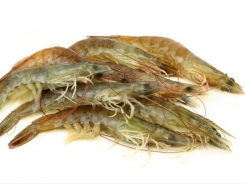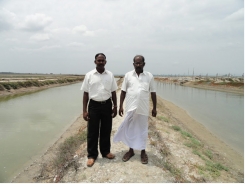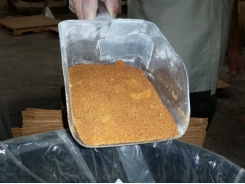Ongoing production issues in shrimp farming, part 1

Producing more shrimp with improved practices
Shrimp grow-out production technology is still mostly extensive to semi-intensive. There is considerable potential to improve production efficiency through innovation, standardization and automation at various levels.
The global shrimp farming industry is more than 40 years old, and production has been increasing steadily in the last two decades, from about 1 million metric tons (MMT) in 1995 to over 4 MMT currently. It is projected to expand significantly in the next two decades, particularly in Southeast Asia, India and Latin America.
Ongoing consolidation within the industry both in Asia and the Americas is resulting in several large and vertically integrated companies that can maximize their efficiencies and economies of scale. As a result, current production could nearly double by 2030; however, more attention to various ongoing issues is necessary, including genetic improvement, nutritional requirements and feed ingredients, health management, environmental and other issues.
Domestication and genetic improvement
During its first three decades of existence, the commercial shrimp farming industry depended significantly on wild seedstock and broodstock. Many factors can and will affect wild broodstock and wild postlarvae supply, from global weather phenomena like periodic El Niño and annual monsoons, to localized pollution and environmental degradation, to overfishing and/or over-regulation of fisheries. As a result, wild seed supply was often unreliable and limited, and periodic shortages significantly afflicted the industry.
Domestication and selective breeding programs are the basis for modern terrestrial animal and plant production. However, it is a relatively recent undertaking with aquatic species, where commercial selective breeding has been limited to primarily clam and salmon species, with very encouraging results.
Marine shrimp are excellent candidates for domestication and genetic improvement, because of their high fecundity rate, short generation interval and the presence of additive effect of genetic variance for growth rate. However, when compared to most livestock industries, shrimp farming generally is still at a very early stage of domestication and selective breeding.
More discussion and collaboration in both conventional selective breeding techniques and the application of the tools of modern molecular biology – including newer gene editing techniques – can promote global progress and efficiency of genetic improvements in the industry.
Achieving domestication of selected shrimp species, together with selection, genetic improvement – and perhaps even hybridization and ploidy – should be major R&D goals. Efforts to develop and implement high health shrimp systems are important and must continue. An industry with the global importance shrimp farming has achieved cannot depend on nature to reliably supply its seedstock.
Depending on the uncertainty of nature as the source of raw material was not a sound strategy after the industry reached a critical mass, and it is very important to continue working to improve traits like growth, disease resistance, yield and performance with specific dietary ingredients, among others. This will allow the industry a new level of planning and control over production, resulting in an improved capacity to better respond to changing environments, market pressures and other demands.
The industry is based mostly on only one species –the Pacific white or whiteleg shrimp (Litopenaeus vannamei) – with relatively few improved, selectively bred lines. It is the most important shrimp species in the world, with virtually all production coming from aquaculture.
Pacific whites represent around 75 percent of all farmed shrimp globally, and more than 40 percent of all shrimp produced. Perhaps other shrimp species that at one time had prominent roles, like the Pacific blue shrimp (L. stylirostris) and others, merit a second look.
Nutritional requirements and formulated feeds
The development and use of compound aquafeeds has been a major factor in the development of the industry and will continue gaining importance. Reducing the cost of feeds is an aspect critical to further expanding the industry and improving its competitiveness relative to other protein sources, such as fish, beef, pork and poultry.
Knowledge on the nutritional requirements of cultured shrimp species is relatively adequate but there is much room for improvement. Growing inclusion of land-based ingredients has significantly reduced the use of limited ingredients of marine origin, like fishmeal and fish oil, which were very important in shrimp feeds during the first two decades of the industry.
There is much potential to reduce the production cost and improve the nutritional performance of compound feeds for shrimp. Extensive research is ongoing – and must continue – to improve our knowledge of shrimp nutritional requirements and to develop new diets that are species-, area- and even season-specific. These diets could involve additional and innovative manufacturing processes methods; lower-cost and novel and sustainable ingredients; newer health additives and growth promoters that improve survival, growth, yield, conversion and disease resistance while reducing environmental concerns.
There is much pressure to produce lowest-cost feed formulations to minimize feed costs and improve profitability while optimizing production. There also is increasing pressure to reduce ingredient costs through the use of novel and sustainable ingredients. But there should also be emphasis on the lowest-polluting feed formulations for minimizing environmental impact while achieving the greatest compatible aquaculture production possible.
Feed management techniques, as a major component of pond management and now with increasing mechanization and automation options, will continue to gain importance to improve efficiency and minimize environmental impacts of effluents.

The history of the shrimp farming industry shows periodic, major disease outbreaks that disrupt upset supply chains and markets and can be a significant concern to potential investors.
Disease prevention, diagnosis and control
The shrimp farming industry has globally faced spectacular collapses in several countries due to various diseases, particularly of viral origin – like WSSV, YHV and TSV – but lately also of bacterial (AHPND) and microsporidian (EHP) origins. Standard denominators among the shrimp farming industries of many of these countries were an increased incidence of diseases, particularly viral diseases, and quick and mostly unregulated development.
There are still very few alternatives to deal with viral infections, and the best procedure for disease management is exclusion through biosecurity. Similarly, the tools to effectively deal with the newest diseases like AHPND and EHP are somewhat limited too.
The history of the industry is one of periodic, major disease outbreaks (mostly viral) and continuous health management issues that upset markets and supply chains and is a major concern to potential investors. There will undoubtedly be new pathogens that the industry will have confront and manage.
Further improving the ability to accurately and promptly diagnose infectious agents must be a research priority. The application of effective pathogen detection and disease diagnostic methods – particularly those based on molecular biology and recently developed – by the industry is essential (as is continued R&D in these areas) to better understand and prevent losses due to diseases.
Much progress is evident in the last few years, and where some years ago we had only a handful of shrimp disease diagnostic laboratories, there are several around the world effectively serving the industry today.
Best management practices and environmental regulations
The resolution of environmental and social conflicts can be accomplished through regulations, technical assistance, education and various voluntary measures. Much progress has been made on this front over the past two decades, and the shrimp farming industry must continue being proactive and voluntarily self-regulate in lieu of being externally regulated.
Best management practices (BMPs) are a practical way to approach environment management for shrimp farming. They are practices thought to be the most effective, yet practical, methods of reducing environmental impact levels to those compatible with resource management goals. Producers may adopt them voluntarily to show environmental stewardship and reduce the urgency for governmental regulations. However, BMPs also may be the backbone of environmental management in activities where effects are diffused and located over large geographic areas.
The shrimp farming industry, by voluntarily preparing and adopting BMPs, is demonstrating environmental responsibility to reduce the need for future regulations, and to provide a basis for the form of future regulations. Shrimp farming is conducted over a wide range of coastal environments, with significant differences in resource patterns, physical, chemical and biological conditions, so a single system of BMPs for use in all situations may not be practical.
Shrimp producers must consider a number of major certification schemes. Some certifications are more important than others, depending on the targeted export market and its requirements. Major certification schemes should further come together and harmonize their standards so that producers can more cost-effectively opt for this important production, product quality and marketing tool.
The rapid development of the shrimp farming industry has created conflicts over the use of common resources such as coastal land and water, and others like the fishmeal and fish oil used in formulated feeds. With the need for improved cost-efficiency, the industry has adapted various technologies from other older and established industries – for example, the wastewater treatment and poultry industries – like water recirculation technologies, reduced or zero water exchange, biosecurity and increased use of mechanical aeration.
These and other technologies are becoming increasingly important, and for many years there has been a significant industry trend towards a reduced volume of water per kilogram of shrimp produced. But many local and regional governments are, and will continue, exercising increasing pressure to regulate the shrimp farming industry. The shrimp farming industry must continue working to better regulate itself, internally and at its own initiative, along its entire value chain.
Related news
Tools

Phối trộn thức ăn chăn nuôi

Pha dung dịch thủy canh

Định mức cho tôm ăn

Phối trộn phân bón NPK

Xác định tỷ lệ tôm sống

Chuyển đổi đơn vị phân bón

Xác định công suất sục khí

Chuyển đổi đơn vị tôm

Tính diện tích nhà kính

Tính thể tích ao



 Ongoing production issues in shrimp farming, part 2
Ongoing production issues in shrimp farming, part 2  Nutritional evaluation of improved soybean meal in Pacific…
Nutritional evaluation of improved soybean meal in Pacific…